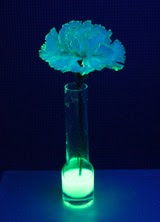Meet Phytoalexins: Natural Plant Antibiotics
Phytochemicals help in defending plants and they are so
intricate, that each taxonomic grouping of plants can be identified by the
unique phytochemicals that are produced by that group. Let us find out more
about phytochemicals...
Meet Phytoalexins: Natural Plant Antibiotics
Love eating veggies? If yes, then you shouldn't miss this information!
Do you know why we make sure infected leaves are removed from leafy vegetables? It is quite amazing to see how nature works. Plants are used as food by animals and humans use plants and animals as our food. Plants have naturally occurring chemicals known as Phytochemicals. Phytochemicals help in defending plants and they are so intricate, that each taxonomic grouping of plants can be identified by the unique phytochemicals that are produced by that group
Pre-existing Defensive Phytochemicals
Most of the biochemical facility of plants is mainly for protection from being used as food by bacteria, fungi, insects and larger herbivores like humans. Domestication of plants has focused mainly on the systematic selection of plant mutants with defective phytochemical defenses. Plants that humans cultivate are not as toxic as the wild ones. Humans have also developed cultural practices of plant selection and food preparation that will avoid or remove the most toxic of residual phytochemicals.
Thus, humans have learned to avoid the leaves of rhubarb and potato plants. Many other plants are fermented, heated or soaked in various different ways to remove the most toxic compounds before consumption.
Damaged or Infected Plants Are Deadly
Many plants that we eat become toxic when pathogens attack them. As a result, the plants produce very dangerous phytochemicals and phytoalexins. This is why when we plan to prepare leafy vegetables like spinach, we make sure to remove the infected parts of the leaves.
The bitter taste of many pre-existing phytochemicals like alkaloids triggers vomiting. In the first trimester of pregnancy, womens embryos are extremely sensitive which is why they are nauseated by the smell of cooking vegetables.
Detoxification of Phytochemicals
We are protected from the natural toxic phytochemicals that are common in vegetables as some of those chemicals are not absorbed by our bodies. The lining of the intestines and the liver produce enzymes that modify phytochemicals in order to render them harmless. This is why we can eat many vegetables that would otherwise kill dogs or cats since they have different defenses against phytochemicals
Uses of Phytochemicals
Although phytochemicals are toxic, they can be also be used as antibiotics to reduce the growth of human bacterial or fungal pathogens in food. Herbs and spices that are developed protect us against particular pathogens in foods. This is how we have smartly learnt to use phytochemicals to make our food healthier.
Meet Phytoalexins: Natural Plant Antibiotics
Love eating veggies? If yes, then you shouldn't miss this information!
Do you know why we make sure infected leaves are removed from leafy vegetables? It is quite amazing to see how nature works. Plants are used as food by animals and humans use plants and animals as our food. Plants have naturally occurring chemicals known as Phytochemicals. Phytochemicals help in defending plants and they are so intricate, that each taxonomic grouping of plants can be identified by the unique phytochemicals that are produced by that group
Pre-existing Defensive Phytochemicals
Most of the biochemical facility of plants is mainly for protection from being used as food by bacteria, fungi, insects and larger herbivores like humans. Domestication of plants has focused mainly on the systematic selection of plant mutants with defective phytochemical defenses. Plants that humans cultivate are not as toxic as the wild ones. Humans have also developed cultural practices of plant selection and food preparation that will avoid or remove the most toxic of residual phytochemicals.
Thus, humans have learned to avoid the leaves of rhubarb and potato plants. Many other plants are fermented, heated or soaked in various different ways to remove the most toxic compounds before consumption.
Damaged or Infected Plants Are Deadly
Many plants that we eat become toxic when pathogens attack them. As a result, the plants produce very dangerous phytochemicals and phytoalexins. This is why when we plan to prepare leafy vegetables like spinach, we make sure to remove the infected parts of the leaves.
The bitter taste of many pre-existing phytochemicals like alkaloids triggers vomiting. In the first trimester of pregnancy, womens embryos are extremely sensitive which is why they are nauseated by the smell of cooking vegetables.
Detoxification of Phytochemicals
We are protected from the natural toxic phytochemicals that are common in vegetables as some of those chemicals are not absorbed by our bodies. The lining of the intestines and the liver produce enzymes that modify phytochemicals in order to render them harmless. This is why we can eat many vegetables that would otherwise kill dogs or cats since they have different defenses against phytochemicals
Uses of Phytochemicals
Although phytochemicals are toxic, they can be also be used as antibiotics to reduce the growth of human bacterial or fungal pathogens in food. Herbs and spices that are developed protect us against particular pathogens in foods. This is how we have smartly learnt to use phytochemicals to make our food healthier.


Comments
Post a Comment